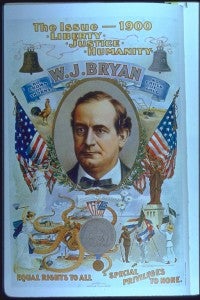Title: “No Crown of Thorns, No Cross of Gold…”
About the image: William Jennings Bryan on a 1900 campaign poster. Symbols of the plow and the rooster; trusts as an octopus’ tentacles over industry.
Why does Davis High School Teacher, Kevin Williams, find this image interesting?
I find this image usable in several different ways in the classroom. First, it could be used as a warm up for the election of 1900. From the image, students can be lead to identify three central issues: farmers and monetary policy, American foreign policy, and the influence of trusts. The words that appear on this document also provide fodder for discussion. They are loaded and clearly show the biases of Bryan the candidate. I ask students to determine Bryan’s stance on the issues using the images and words.
Second, the image is useful as part of an investigation on campaigns. A comparison of this campaign poster and a McKinley poster shows the differences in campaigning techniques between 1900 and today. (A great McKinley poster for comparison can be found here.) You could also ask students to compare this campaign material to the political cartoons published during the election cycle of 1900. The Harp Week website “Presidential Elections 1860-1912,” is a great resource for this.
Finally, this would be a marvelous source to bring into any discussion of the Scopes Monkey Trial. William Jennings Bryan is possibly best remembered for his conservative role in the prosecution of John Scopes. I want students to know that Bryan wasn’t simply a reactionary, but was considered somewhat radical and revolutionary at other points in his life. After all, he did promote government ownership of railroads in the election of 1908. This campaign poster could create a more complete picture of a very complex and important historical man.
Related Topics/Themed Collections: National Politics, Gilded Age
Lessons in the Marchand Collection:
- How Progressive Were the Progressives? by Kevin Williams, CHSS 11.2, IN PRINT – AVAILABLE IN THE MARCHAND ROOM, ONLINE – AVAILABLE FROM THE BEST OF YOLO COUNTY SYMPOSIUM
Resources Available in the Marchand Collection:
- Brett Flehinger, The 1912 Election and the Power of Progressivism: A Brief History with Documents, Boston: Bedford/St. Martin’s, 2003.
- Ellen F. Fitzpatrick, ed., Muckraking: Three Landmark Articles, Boston: Bedford/St. Martin’s, 1994.
- Glenda Elizabeth Gilmore, ed., Who Were the Progressives?, Boston: Bedford/St. Martin’s, 2002.
- The Progressive Era: The Limits of Reform, Social Science Education Consortium, 1989.
Share your ideas! How would you use this image? Click here to let us know.
